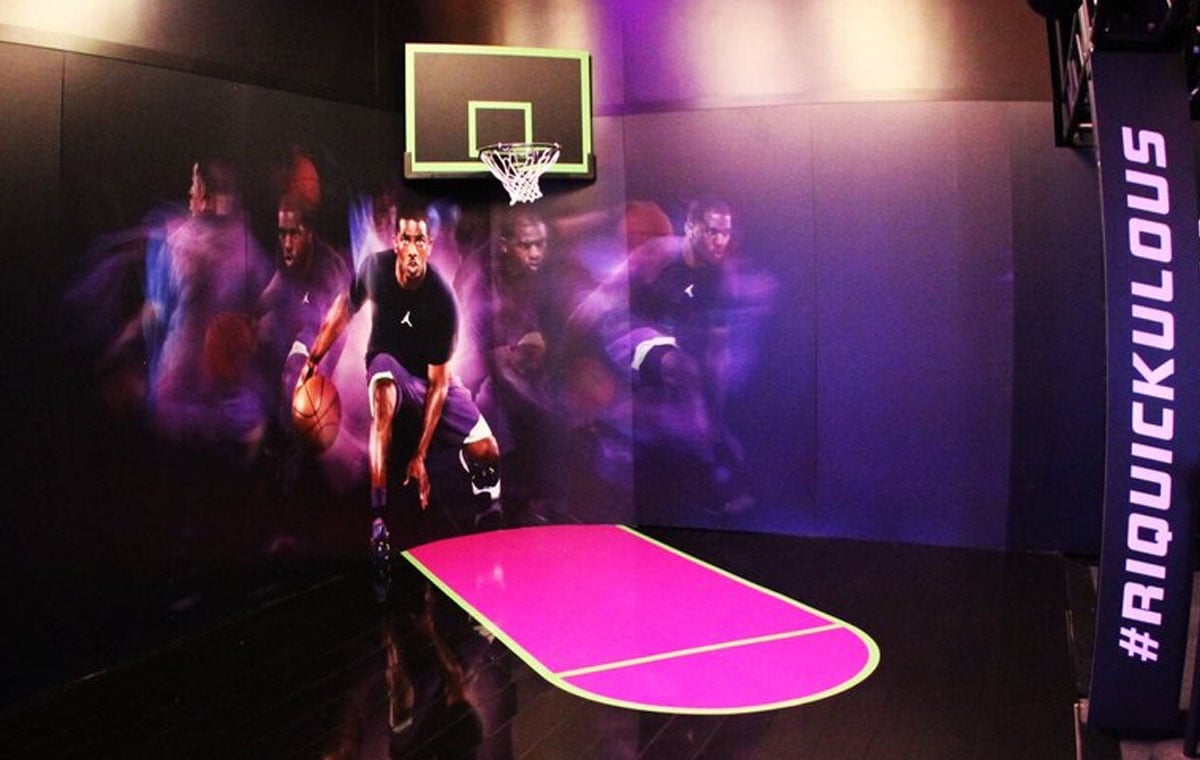Gone are the days of simply stocking shelves and calling it a day. Now, retailers must create immersive experiences that engage and captivate consumers. Digital touchscreens were a step in the right direction but top retail brands are light years ahead – creating immersive, content-driven interactive retail displays with game-changing technology.
Today’s retail environments push boundaries and blur lines between physical and digital spaces. Modern technology including holography, OLED displays, projection mapping, interactive floor tiles, smart mirrors, and digital ceilings are elevating the consumer experience and allowing brands to inform and connect with customers in unexpected ways.
These cutting-edge technologies create dynamic and memorable retail experiences that increase dwell time, encourage customers to explore more products, and keep them coming back for more. In this article, we'll explore how these innovations are changing the customer shopping experience and what you need to know to stay ahead of the curve. Discover 7 modern technologies elevating the retail environment and inspiring customers to get out of the house and shop in person.
7 High-Tech Trends Revolutionizing Interactive Retail Displays
1. Holography: Creating Captivating Illusions
Holography—the technology that creates three-dimensional images through light interference patterns— allows brands to showcase products in ways previously confined to science fiction, captivating customers and drawing them into immersive brand experiences.
Clothing retailers can leverage holography by displaying outfits on virtual models that rotate and move, allowing customers to view the garments from every angle. An electronics brand might use the technology to display a 3D hologram of the latest smartphone, zooming in on its features without customers ever touching a physical device.
Benefits for brands: Holographic displays create a "wow" factor that stops shoppers in their tracks, encouraging longer dwell times and increased product interaction. Holography also allows customers to visualize products in ways not possible with traditional retail displays, enhancing the overall shopping experience and providing a better understanding of product features, potentially increasing conversion rates.

2. OLED Displays: Vivid and Flexible Screens
OLED (Organic Light Emitting Diode) technology creates dynamic interactive retail displays with vibrant colors, flexibility, and energy efficiency. These ultra-thin, bendable screens offer unprecedented opportunities for creative and dynamic store layouts, allowing retailers to update content seamlessly and adapt to changing market trends.
Fashion retailers might use OLED displays to showcase real-time fashion trends or direct customer attention to certain features or products. Beauty stores may leverage them for interactive tutorials and product information, helping to differentiate their brand. The flexibility of OLED panels means they can be integrated into curved surfaces or even wrapped around pillars, maximizing every inch of display space.
Benefits for brands:
- Displaying high-quality, detailed product information enhances the customer's ability to make informed purchasing decisions.
- OLED displays can be easily reconfigured and updated across multiple locations via centralized content management systems, creating a seamless experience for customers across touchpoints and a streamlined option for refreshing content efficiently.
- Content can also be tailored to individual locations to reflect timely regional events, or trending products, creating a more personalized experience.

Motorola engages showroom visitors with a digital floor projection.
3. Projection Mapping: Transforming Any Surface
Projection mapping turns ordinary surfaces into extraordinary canvases, allowing retailers to create dynamic, attention-grabbing displays without permanent installations. This technology can transform walls, floors, or even merchandise into digital storytelling platforms.
Consider a shoe store that uses projection mapping to turn its walls into ever-changing landscapes, showcasing the versatility of its hiking boots across different terrains. Or imagine a home furnishing outlet that projects various room settings onto blank walls, demonstrating how their products would look in a customer's home. Projection mapping adds an element of surprise and innovation, keeping customers engaged and encouraging them to explore the store.
Benefits for brands:
- Projection mapping allows for unique, memorable brand storytelling that can set a retailer apart from competitors.
- By creating engaging product demonstrations or highlighting specific items, projection mapping can direct attention to high-margin or promotional products, helping to boost revenue.
- Projection mapping can help facilitate and direct the in-store customer journey, guiding shoppers strategically through the store, and past targeted touchpoints.
4. Interactive Floor Tiles: Engaging Pathways
Interactive floor tiles are turning retail spaces into playgrounds for customer engagement. These pressure-sensitive or motion-detecting tiles can be programmed to light up, display images, or trigger sounds when stepped on, creating an immersive and interactive retail experience.
Toy stores employ this technology to create game zones that entertain children (and adults) while parents shop. Supermarkets use interactive floors to guide customers to promotional items or create engaging product showcases. For example, a beverage brand might create a "river" of light that flows toward its product display, subtly directing customer traffic.
Benefits for brands:
- The fun, playful nature of these interactive retail displays can create positive associations with the brand, particularly among younger consumers.
- Innovative use of floor space also sets a brand apart and creates a unique in-store atmosphere.
- Interactive pathways can make navigation more intuitive and enjoyable, especially in large stores.
5. Smart Mirrors: Personalized Reflection
Smart mirrors are elevating the retail try-on experience. These high-tech mirrors combine cameras, displays, and augmented reality (AR) to allow customers to virtually try on clothes, accessories, or makeup without physically changing outfits or applying products.
Clothing retailers utilize smart mirrors to let customers quickly cycle through different outfit combinations, colors, and sizes. Makeup brands offer virtual makeovers—allowing customers to experiment with different looks instantly. This smart retail technology not only personalizes the shopping experience but also reduces the need for extensive physical inventory in-store.
Benefits for brands:
- By reducing barriers to trying products, smart mirrors can increase the likelihood of purchases and reduce return rates.
- Virtual try-ons encourage customers to experiment with more products than they might physically try.
- Personalized recommendations and virtual try-ons can make customers feel more connected to and understood by the brand.

A mockup of a digital ceiling concept for an interactive magic store
6. Digital Ceilings: The Sky’s the Limit
Digital ceilings are transforming oft-neglected overhead spaces into captivating visual displays. By installing LED panels or using projection technology on the ceiling, retailers can create immersive environments that envelop customers in the brand experience.
Department stores are using digital ceilings to display seasonal themes, creating a winter wonderland during the holidays or a sunny beach scene for summer collections. Restaurants and cafes are crafting unique dining experiences with ever-changing sky views or artistic displays overhead. This technology not only enhances the atmosphere but also provides additional advertising space that can be creatively utilized.
Benefits for brands:
- Utilizing often-overlooked ceiling space for branding and atmosphere creation sets a retailer apart.
- Thematic displays can create moods that encourage purchasing behavior, such as a cozy winter scene promoting warm clothing.
- Immersive environments can create strong emotional connections and positive associations with the brand.

Converse offers customization at a recent pop-up along the Magnificent Mile in Chicago.
7. Product Customization: Leveraging One of a Kind Opportunities
In-store product customization is turning passive shoppers into active participants in the creation of their purchases. By offering on-the-spot personalization through technologies like 3D printing, embroidery machines, or heat presses, brands can create unique, engaging experiences that result in truly one-of-a-kind products.
Imagine an athletic apparel brand setting up a pop-up customization station during major sporting events, allowing fans to personalize jerseys or caps with their favorite team's colors and logos. Or picture a beauty brand offering a "create your own palette" display where customers can mix and match eyeshadow shades to suit their individual preferences. These interactive experiences not only drive sales but also generate social media buzz and strengthen emotional connections with the brand.
Benefits for brands:
- Allows retailers to capitalize on transient events
- Actively involves customers in the creation process, leading to higher engagement and emotional investment.
- Generates earned media through shareable experiences
- Customized products often command premium prices and can lead to increased overall purchase values.
Interactive multimedia technologies like holography, digital projection mapping, interactive floor tiles, customization, and digital ceilings profoundly transform interactive retail displays. These cutting-edge tools are reshaping how consumers interact with retail environments, creating immersive and memorable experiences that go far beyond traditional shopping. By leveraging these technologies, retailers can significantly enhance visual appeal, engage customers on a deeper level, and ultimately drive more foot traffic and sales. But the best application of technology is never just to keep up with trends. Any technology should align with the brand’s goals, objectives, and aesthetics, resonate with the audience, and improve the customer experience.
At Bridgewater Studio, we offer end-to-end strategy, design, and production services to help brands strategize how best to leverage technology in their retail interiors, design interactive retail displays that further the brand or product story and fabricate all components to function seamlessly in the retail environment. If you’re ready to elevate your space, schedule a no-obligation strategy session with Bridgewater today and discover how we can help you enhance your customers’ experience by leveraging these game-changing technologies in your store.


.png)
.png)
.png)







